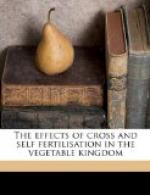2. Mimulus luteus.
During the three first generations the intercrossed plants taken together exceeded in height the self-fertilised taken together, in the ratio of 100 to 65, and in fertility in a still higher degree. In the fourth generation a new variety, which grew taller and had whiter and larger flowers than the old varieties, began to prevail, especially amongst the self-fertilised plants. This variety transmitted its characters with remarkable fidelity, so that all the plants in the later self-fertilised generations belonged to it. These consequently exceeded the intercrossed plants considerably in height. Thus in the seventh generation the intercrossed plants were to the self-fertilised in height as 100 to 137. It is a more remarkable fact that the self-fertilised plants of the sixth generation had become much more fertile than the intercrossed plants, judging by the number of capsules spontaneously produced, in the ratio of 147 to 100. This variety, which as we have seen appeared amongst the plants of the fourth self-fertilised generation, resembles in almost all its constitutional peculiarities the variety called Hero which appeared in the sixth self-fertilised generation of Ipomoea. No other such case, with the partial exception of that of Nicotiana, occurred in my experiments, carried on during eleven years.
Two plants of this variety of Mimulus, belonging to the sixth self-fertilised generation, and growing in separate pots, were intercrossed; and some flowers on the same plants were again self-fertilised. From the seeds thus obtained, plants derived from a cross between the self-fertilised plants, and others of the seventh self-fertilised generation, were raised. But this cross did not do the least good, the intercrossed plants being inferior in height to the self-fertilised, in the ratio of 100 to 110. This case is exactly parallel with that given under Ipomoea, of the grandchildren of Hero, and apparently of its great-grandchildren; for the seedlings raised by intercrossing these plants were not in any way superior to those of the corresponding generation raised from the self-fertilised flowers. Therefore in these several cases the crossing of plants, which had been self-fertilised for several generations and which had been cultivated all the time under as nearly as possible the same conditions, was not in the least beneficial.




